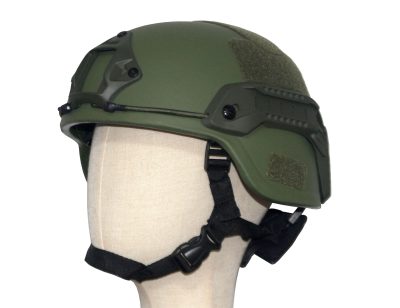Combat helmets have come a long way since their inception, evolving to meet the ever-changing demands of modern warfare. From the early days of the Personnel Armor System for Ground Troops (PASGT) to the cutting-edge WENDY helmet, advancements in technology and design have significantly enhanced soldier safety on the battlefield.
This article explores the journey of combat helmets, highlighting key innovations, the impact of new materials, and how these protective gear advancements continue to shape military operations. As we delve into this evolution, we’ll see not just how helmets have changed, but why these changes are crucial for the protection of our troops.

Bronze Age to Roman Innovation
The evolution of combat helmets can be traced back to ancient times, with early examples emerging during the Bronze Age. Warriors recognized the need for head protection, and over time, materials and designs improved as civilizations advanced.
Bronze Age helmets were simple yet functional, often made from bronze or copper. These early helmets prioritized basic protection over comfort or visibility.
Key features of Bronze Age helmets:
- Materials: Primarily bronze and copper.
- Design: Domed or conical shapes to deflect blows.
- Coverage: Limited to covering the top of the head, leaving the face exposed.
Roman helmet innovations:

- Materials: Transition from bronze to iron for enhanced strength.
- Design: The Roman galea featured neck guards and cheek plates for greater coverage.
- Customization: Helmets were designed for specific ranks, with centurions and officers having crests for easy identification.
- Mass production: The Roman army’s size required helmets to be produced at scale, leading to standardized designs.
Diversity And Design in European Armor
During the Middle Ages, European armor saw significant diversification in both design and functionality. As warfare evolved, so did the need for helmets that could protect against more sophisticated weapons, while still allowing soldiers to maintain mobility and vision. The result was a wide array of helmet designs, each tailored to different regions, combat styles, and social classes.
Key helmet types in medieval Europe:
- Great Helm: Popular during the 12th and 13th centuries, this cylindrical helmet offered full-face protection. It was heavy and cumbersome but provided excellent defense against sword strikes.
- Bascinet: By the 14th century, knights favored this helmet for its pointed shape, which deflected blows. It featured a hinged visor for facial protection while allowing improved airflow.
- Sallet: Common in the 15th century, this lightweight helmet had a sleek design with a visor that covered the face and a tail that protected the back of the neck.
First Generation Helmets and World War I Innovations
World War I introduced unprecedented dangers on the battlefield, particularly from shrapnel and artillery. In response, combat helmets were reintroduced to protect soldiers from these new threats. This era marked the birth of the first modern helmets, designed with functionality and mass production in mind .
Brodie Helmet

The Brodie helmet , introduced by the British in 1915, became a standard issue for troops in trench warfare.
- Design : A wide-brimmed, shallow steel helmet that protected against shrapnel and overhead debris.
- Mass adoption : Used extensively by British, Commonwealth, and American forces during the war.
- Strengths : Offered better protection than cloth caps and quickly became a symbol of WWI soldiers.
Stahlhelm

Germany introduced the Stahlhelm in 1916 as a response to the growing dangers of trench warfare.
- Design : A deeper, bucket-shaped helmet that covers the head, neck, and ears.
- Protection : Provided superior ballistic protection compared to the Brodie, especially from side impacts.
- Legacy : The Stahlhelm influenced many future helmet designs and became iconic in German military history.
World War II developments and introduction of Kevlar
World War II saw significant advancements in helmet design and mass production, as the need for better protection became a priority. Helmets were improved not only for their protective qualities but also for comfort and adaptability in diverse combat environments. This period also set the stage for post-war innovations, eventually leading to the introduction of Kevlar.
M1 Helmet

The M1 helmet became the standard issue for US forces during World War II.
- Design : A more ergonomic, two-piece design with a hard steel outer shell and an inner liner for comfort.
- Widespread use : Adopted by US forces and used through multiple wars until the 1980s.
- Versatility : Its adaptable design allowed soldiers to customize it with camouflage netting or additional padding.
Stahlhelm (WWII version)
Germany continued using the Stahlhelm , refining it for better protection and durability during WWII.
- Design : Retained the deep, bucket shape with minor modifications for greater strength.
- Improvements : Offered excellent ballistic protection, especially against shrapnel and small arms fire.
- Legacy : The helmet remained iconic and was further modernized for post-war use by other nations.
Introduction of Kevlar
Though not used during World War II, the groundwork for Kevlar helmets began post-war as scientists searched for stronger, lighter materials.
- Kevlar’s impact : By the 1970s, Kevlar replaced steel as the primary material, offering significantly better protection without added weight.
- Long-term use : Kevlar helmets became the new standard, influencing modern combat gear like the PASGT, ACH, and beyond.
Third Generation: Integration of Communication and Vision Technologies
The third generation of combat helmets not only focused on protection but also integrated cutting-edge communication and vision technologies. This era saw the evolution of helmets from simple defensive gear to multifunctional tools designed to enhance situational awareness and battlefield coordination. With the rise of modern warfare, these helmets incorporated advanced materials and modular systems for greater flexibility.

Bulletproof PASGT Helmet

The Personnel Armor System for Ground Troops (PASGT) helmet, introduced in the 1980s, marked the transition from steel to Kevlar.
- Design : Made from Kevlar, offering enhanced bullet and shrapnel resistance.
- Features : Provided better coverage than previous helmets, protecting the head, neck, and ears.
- Adoption : Widely used by US forces and other NATO members, with modifications for comfort and adaptability.
Bulletproof MICH Helmets

The Modular Integrated Communications Helmet (MICH) and Advanced Combat Helmet (ACH) represent major advancements in modern combat helmets.
- Design : Lightweight, made from Kevlar or composite materials for enhanced protection.
- Technology : Integrated with communication systems, allowing soldiers to stay connected in real-time combat situations.
- Features : Compatible with night vision goggles and other tactical equipment, improving both protection and functionality in modern combat.
Bulletproof FAST Helmet

The Future Assault Shell Technology (FAST) helmet is a high-performance combat helmet designed for the most demanding tactical environments.
- Design : Lightweight and made from advanced materials, offering high-level ballistic protection.
- Features : Equipped with side rails and mounting points for attaching communication devices, cameras, and night vision goggles.
- Ventilation : Includes a unique ventilation system for increased comfort during high-intensity operations.
Bulletproof Wendy Helmet

The Wendy helmet is a cutting-edge combat helmet designed for maximum protection and modular use.
- Design : Built with advanced materials, offering high-level ballistic protection and impact resistance.
- Modularity : Allows for the attachment of communication systems, cameras, and night vision devices.
- Comfort : Lightweight and ergonomically designed for extended use without compromising mobility.
Wrap-Up!
The evolution of combat helmets, from the early steel designs of World War I to today’s high-tech, modular helmets, showcases the continuous drive to protect and equip soldiers with the best possible gear. Each generation of helmets has responded to the changing demands of demands warfare, incorporating advances in materials, protection, and functionality.
